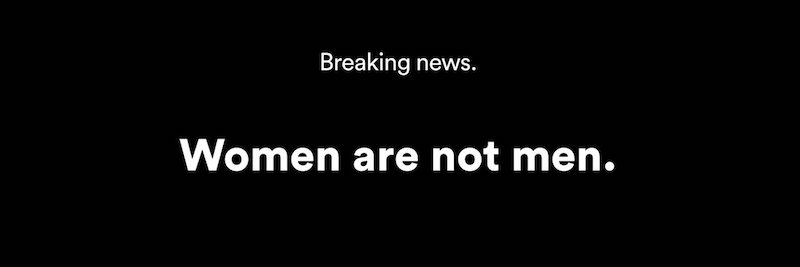
“Breaking: Women are not men.” What seems obvious to most, has long been ignored by companies creating some of the most popular smart watches and fitness trackers on the market today. “Default male” design is costing companies billions, as was outlined in a recent article on Wired.
Virtual reality headsets, billed as the future of gaming and workplace training, are too large for women’s heads. Google’s speech recognition software struggles to understand women speaking. These biases are frustrating in everyday life, but they quickly become dangerous when they filter into technology designed to improve our health. […]
This bad data can give women a warped view of reality: technology is trying to tell them how they are performing but the results are wildly inaccurate because it assumes they are men.
“Fitness trackers and wearables are ignoring a $50bn market: Women” – Wired
Wild AI founder Helene Guillaume is on a mission to change that and is working on technology to elevate the capabilities of the female body. Her company has created a mobile application for female athletes that tracks data such as menstrual cycles, digestion, daily activities, and sleep in order for the athletes to optimize their physical performance. The company has a big vision: To create a future where every woman on the planet can access the knowledge, support and power to perform.
We caught up with Helene to see how far they’ve come and what we can expect from Wild AI in 2020 and beyond.

What does WILD.AI do and how does it compare to fitness trackers currently on the market?
Helene Guillaume: With WILD.AI, we help women understand their body, what they feel. We are able to tell them in advance the symptoms they may face, how to alleviate those, based on knowledge built from our algorithms and data of women with similar profiles.
We start with women who do sports, as they have data and are highly engaged; we provide them personalized and adaptive recommendations on their training, nutrition and recovery, through our first product, a B2C app.
On how we compete with fitness trackers and other training apps: those are usually made by men, for men. There is one company, FitrWoman, who has an interesting approach across both trainings and the menstrual cycle. But that’s basically it in the market.
My wish is that no one, in 5 years time, would need to ask how different is a man to a woman. It sounds obvious, but if I ask people to give examples, they still struggle. Books like Invisible women by Caroline Criado-Perez, or ROAR by Stacy Sims (who works with us), are now bringing attention, so things are changing.
Basically, a boy who goes through puberty, builds up testosterone, muscles, and feels immortal – until he’s 45 or 50. But a girl gets weird boobs, her periods, losses confidence and feels weak – while going through testing 5 different pills to fight acne, then abortion, trying to get pregnant, post-pregnancy or 10 years in perimenopause, with common misdiagnosed “period pain” endometriosis (10% women), Polycystic ovary syndrome (PCOS, 10%), irritable bowel syndrome (some 30% women). And for 40 years, or some 500 menstrual cycles, her body changes on a daily basis: her digestion, nutritional needs (iron, electrolytes,…), joint laxity (ACL injury is linked to ovulation), strength and sex drive.
The good news, is that women are not that unpredictable, moody species.
We actually follow patterns, time series. Both in terms of our needs/input (nutritional, training, recovery), and how we create power/output. With a correct input, the output can drastically be amplified.
At WILD.AI, we split the menstrual cycle in 5 phases: early follicular (when you have your periods), late follicular, ovulation, early luteal, late luteal (when you might experience premenstrual symptoms). For each of these phases, recommendations are personalized, and as we get feedback from each women, the system learns the different types of profiles, and what works for each of them.
How exactly does WILD.AI work? It’s an app. Does it connect to different fitness trackers via API or largely rely on manual entry? Any plans to develop your own tracker?
HG: As a woman training for an event (eg. NYC Marathon), you would sign up, complete an onboarding with questions on you – sports, menstrual cycle, health; connect your wearables. From there, we generate a training plan to you, that takes into account your menstrual cycle. The plan is adaptive – as a human coach would do, depending on the feedback we get, and where you are in your cycle, we would increase or decrease intensity, recommend what to eat to alleviate symptoms and make the most out of each training, while optimizing recovery. For instance, we would predict that you will be bloated in two days, given that you’re entering the late luteal phase – with premenstrual symptoms. You then tell the app if it’s true or not. We learn. We can then recommend you what to do to alleviate those symptoms, such as increasing your electrolyte intake a few days before. If it improved the bloating, we learn. As such, the product becomes better with every insight feedback, we build profiles on each woman, and we are able to become highly personalized and adaptive: a leapfrog into the future of personal health, as Eric Topol predicts it: individuals should soon be able to improve their daily lives by eating exactly what is good for them, when it’s good for them, understand why, have a proper and data-backed preventative approach to their health.
You can connect with your wearables and apps – like Garmin or Strava; which we get your automatic data from. You then enter manual data daily – your sleep quality, how fast you fell asleep, any pains, digestive issues, details on your menstrual cycle, mood, stress, the toughness of a training, etc. Manual tracking can be a hard challenge to nail – but we have on of the best people to create this: the co-founder and CPO of Clue is now our CPO, and leading the way for easy input.
This enables us to create the largest database of female datasets across all ages, life stages and ethnicities, to properly advance female health and research.
We act and want to act as a platform, using the data from not only trackers, but also other types of data-generating sources: blood tests, smear tests, etc. We are developing a femtech consortium to collaborate on that front: as products created for women, a company creating female condoms or breast pumps has an audience that could be interested in WILD.AI. We develop this consortium to be able to share the CAC to our very specific target customer: women!
WILD.AI was initially developed for female athletes. How do women, who don’t compete in sports benefit from the app?
HG: From women who do sports, we create the profiles of women: a woman who is 22 and taking the pill does not have the same body than a 47 peri-menopausal woman. My digestion might be heavily impacted by my stress and menstrual cycle, while another woman might have a perfect digestion, all the time. Ethnicities is also a crucial element and must be taken into account.
Our first cohorts of women – aiming to solve a specific challenge: sports – have data, from their wearables, and are heavily engaged, entering manual data diligently, as they have a daily reward for it.
As we’ll have the profiles behind (what we call their “BIS”, Body Information System”), we’ll be able to expand to all women looking at their wellbeing and keen to approach each day with confidence, knowing what will happen to them, all the time, and what to do to fulfill their potential.
We already have a lot of demand from the more general population. Being able to serve them is our goal, and different funding strategies could mean serving them earlier.
WILD.AI is currently looking to raise $500K. What stage is the company currently in and what can we expect in 2020?
HG: We’re in the last days for this convertible round, leading to a larger round. Our product is ready to launch, with very positive feedback from our close-beta users: “ The app is awesome.
You can tell it’s a female athlete who created it. It tells you what and why, takes into account your mental wellbeing”. “I have been waiting for this forever”.
Momentum could not be better – we are picked up by the press like WIRED or Forbes, which did a 2 pages article on us in January 2020 – or Femstreet!
I’m very proud of our team – from the co-founder of Clue, a legend in Femtech (as they invented the word femtech!) to Stacy Sims helping us (300k views on her TEDx, legend in female health!), or Paula Radcliffe endorsing us. We also attract people willing to challenge the status quo in our female expert panel, from the CEO of Ineos (best cycling team in the world, also behind the 1h59 marathon record – male!); the head of Stanford Innovation Lab, researchers and professors from Stanford and other universities, journalists,… We aim to be a leader in changing the way people perceive what is “a woman”. Not a fragile being, but these kickass beings capable of producing a human, while working, while racing. Women are incredible, we work to provide them with the knowledge and tools to fulfill their potential.
You also talk about access to an “engaged community”. Is the plan to include social networking elements in the app?
Absolutely. We already have very engaged ambassadors we wouldn’t be able to build WILD.AI without, like Lydia or pro cyclist Nicolle, who are on our Slack channels, have regular calls with us. Women crave knowing how other women like them approach their lives, diets, trainings – so building a sharing community makes a lot of sense. The power of using data and technology behind enables us to push forward research and ultra-personalization. The past is forums, where a lot of precious information may get lost; the future is a system that enables to learn what worked for a specific situation, for a specific profile, and recommend that to other people. It’s a federated knowledge system that is the leap-frog to a personalized and preventative approach to our health. The predictions of Eric Topol of the future of medicine becoming true.




1 Comment
Kimberly_Campbell
Because of the risks associated in trials, historically drugs have been able to go on the market without specific testing of pregnant women. “One thing I find shocking is, because we think there might be a risk, we prefer to be completely blind. So we are like ‘OK, maybe she is going to be pregnant, so let’s not test women at all,’” Guillaume said.